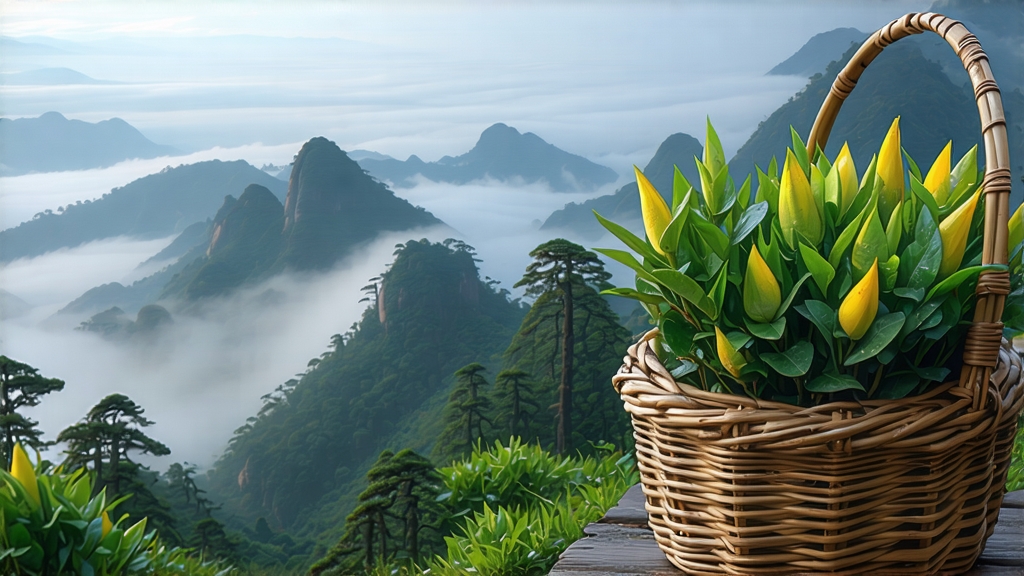
Tucked high above the Sichuan basin, where the Himalayas begin their gentle eastward descent, lies Meng Ding Mountain, a ridge so often wrapped in silver fog that local poets call it “the sky’s ink-wash painting.” It is here, among stone temples built during the Han dynasty and cliff-side paths trodden by Tang dynasty monks, that Meng Ding Huang Ya—literally “Meng Ding Yellow Bud”—has quietly persisted for more than twelve centuries. Unlike the better-known green dragons of Longjing or the rock phoenixes of Wuyi, this yellow tea has never sought the spotlight; instead, it perfected the art of whispering. To international drinkers accustomed to the brisk snap of sencha or the malty embrace of Assam, Meng Ding Huang Ya offers a different grammar of flavor: a silky, almost custard-like liquor that smells of fresh chestnut, steamed corn milk, and mountain orchids, finishing with a returning sweetness Chinese tasters call huigan. Understanding why this happens—and why it almost vanished—requires stepping backward through dynastic cookbooks, imperial ledgers, and the delicate chemistry of “sealed yellowing,” a process so subtle that a single impatient afternoon can turn gold into green.
Historical scrolls first record Meng Ding tea in 53 BCE, when the monk Wu Lizhen planted seven tea bushes on the summit, believing the altitude—1,450 m above sea level—brought him closer to the bodhisattvas. By the Tang dynasty (618-907 CE) the leaves were pressed into cakes and sent down the Min River to Chang’an, capital of the empire. When Song emperor Huizong—himself a gifted tea aesthete—visited Sichuan in 1107, he declared Meng Ding one of four “wonder teas,” and palace painters were ordered to depict its harvest in minute detail. The name “yellow bud” appears officially in 1555, during the Ming, when the court switched from compressed bricks to loose-leaf tribute. Because the imperial courier demanded buds so early that mountain nights still carried frost, villagers invented a slow oxidation method that both reduced grassy astringency and produced a golden hue—thus distinguishing it from the sharper green teas of neighboring counties. For three hundred years a caravan of porters carried the finished tea in oiled-paper cylinders, trekking 1,800 km to Beijing in exactly twenty-eight days so that the emperor could taste spring before it reached the palace gardens.
Botanically, Meng Ding Huang Ya is picked from a small-leaf landrace Camellia sinensis var. sinensis locally nicknamed “old-mother bush.” Its buds are extraordinarily short and plump—barely one centimeter—protected by a downy scale that glows ivory against the dark March canopy. Growers insist on three meteorological omens before plucking: the mountain must be wrapped in mist at dawn, the thermometer must read 4–8 °C, and the first oriole must have been heard. Only the terminal bud plus half-open first leaf are taken, a grade called “sparrow’s tongue.” A master picker can gather just 600 g in a day, and it takes 48,000 buds to yield one finished kilogram. Such parsimony explains why annual production seldom exceeds three tons, most of which is pre-sold to collectors in Chengdu, Shanghai, and increasingly, Berlin.
The craft that converts these jade buds into golden needles is known menhuang—“sealed yellowing”—a technique that sits conceptually between green tea’s kill-green and white tea’s withering. Immediately after picking, the buds are spread on bamboo trays for six hours of mountain wind-withering, losing about 10 % moisture and developing a faint grassy perfume. Next comes the kill-green, but here the wok is cooler (140 °C) and the hand-to-leaf contact gentler than in Longjing; the goal is to rupture only 30 % of cell walls so that polyphenol oxidase survives. While still warm, the half-deactivated buds are wrapped in thick cotton cloth and placed inside a pine-wood box lined with wet rice paper. This bundle is then slid into a cave-like cellar beneath the monastery where humidity hovers at 85 % and temperature at 28 °C. For the next 72 hours the tea master visits every four hours to unwrap, sniff, turn, and re-wrap the leaves, coaxing a non-enzymatic oxidation that turns chlorophyll into pheophytin and forms the characteristic yellow pigment. If the cloth is opened too early the liquor stays green and astringent; too late and